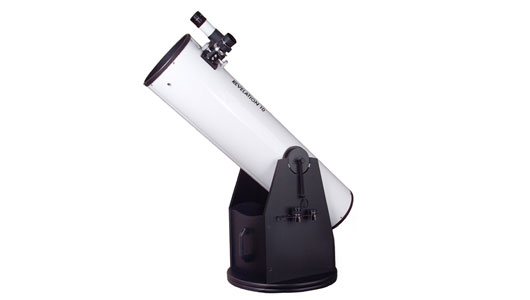Revelation 10 Dobsonian Reflector Telescope
Specification
- 10-inch optical mirror
- 2-inch, dual-speed, Crayford focuser
- Cooling fan
- 8x50 finderscope or Red Dot Finder
- Included 2-inch-to-1.25-inch eyepiece adapter
- Quick collimation screws for easy mirror alignment
- 32mm, 2-inch-format, wide field and 1.25-inch, 9mm Plossl eyepieces
Our largest telescope at present is the GSO Revelation 10, Dobsonian telescope. In 2005. This telescope, won critical acclaim for being one of the cheapest telescopes of its type, at a very low price point. The versions of this telescope have been available in the USA for a while and have a reputation for good performance at their price point. This type of telescope is very easy to use, and with its 2 inch eyepieces of the stunning views of the night sky and other planets. This telescope is also an F5 instrument, and due to the size and weight of the primary mirror, requires a collimation check before each observing session.
One of the reasons why this telescope was inexpensive compared to its competitors, was the fact that the Mirror in itself was un-coated. This offers to disadvantages, firstly, coated mirrors are able to outperform this telescope image wise, though compared to the other scopes in our fleet. It still offers a great comparison. The second issue, and for a group like us, a concerning one, is the fact that being an uncoated means it has to be carefully stored to ensure the longevity and performance of the Mirror.
The latest telescopes, at 12 inch diameter can be just as light, take up less space are better made, and can outperform this basic example of a large diameter Dobsonian telescope. Once one looks through it though, all fears are set aside as you are immersed in some stunning views.
Most Newtonian Telescopes have been supplied on equatorial mounts. The
last few years has seen a new commercial telescope available on the market
- the Dobsonian. A Dobsonian is a simple altazimuth mounted Newtonian telescope
which is excellent for beginners and in large sizes is an economical "Light
Bucket". Simple construction means they are easy to look after and
a lot of aperture can be carted around, 200mm to 250mm Dob's can be slung
across the back seat of a car and transported anywhere
Advantages
- Lowest cost per inch of aperture compared to refractors and catadioptrics since mirrors can be produced at less cost than lenses in medium to large apertures.
- Reasonably compact and portable up to focal lengths of 1000mm.
- Excellent for faint deep sky objects such as remote galaxies, nebulae and star clusters due to the generally fast focal ratios (f/4 to f/8).
- Reasonably good for lunar and planetary work.
- Good for deep sky astrophotography (not as convenient and more difficult to use than catadioptrics).
- Low in optical aberrations and delivers very bright images.
Disadvantages
- Open optical tube design allows image-upgrading air currents and air contaminants which over a period of time will degrade the mirror coatings and telescope performance.
- More fragile than refractors or catadioptrics and this require more maintenance (such as collimation).
- Suffer from off-axis coma.
- Large apertures (over 8") are bulky, heavy and tend to be more expensive. For portability 150-200mm are best at f/4-f/8.
- Generally not suited for terrestrial applications.
- Slight light loss due to secondary (diagonal) obstruction when compared with refractors.
Dobsonian's have their place if you know the sky, love deep sky object's
and are just happy to roam the stars. The newest designs are even more portable,
and even have adapters to fit small digital cameras. It is possble to add motors to this type of telescope so tacking is possible, this it is not yet available commercially. One upgrade for the dedicated souls out there.
In summary a Dobsonian is the best general purpose
telescope for those that are happy to roam as they are good on all types of objects and for
starting (basic) astrophotography. Bang fro buck, Dob's offer more aperture than a refractor, but do require more care, as they can require more collimation (alignment of the mirrors) which is quite easy and only takes a minute or two with a bit of practice.
If you wish for the ultimate deep sky telescope, and also a scope which is oh-so-simple to use, then look no further than a Dobsonian.


